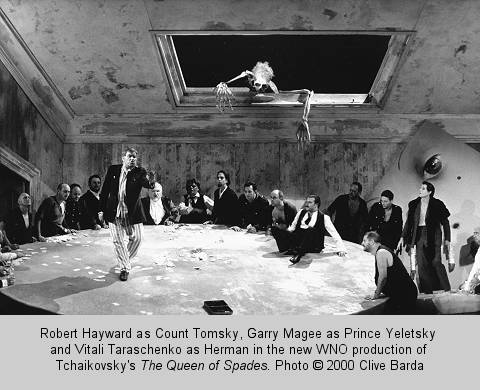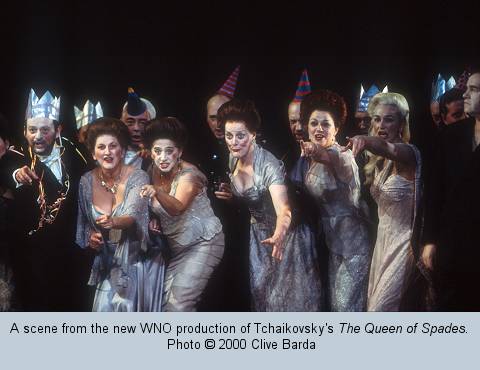|
<< -- 4 -- Roderic Dunnett DANCE OF DEATH


The Queen of Spades - like Nielsen's Maskarade, or Berg's
Wozzeck and Lulu - is a prolonged Dance of Death, and Jones
and Macfarlane are not short of grim, skeletal coups-de-théatre.
Wide open stages and boxed in rooms descending from the fly-tower are familiar
enough : what is original is Jones's use of them. Figures constantly criss-cross
the stage : the variants of these, plus the odd interjected surprise, create
a music, and a choreography, of their own. The number three - a death symbol
integral to the opera - is pounded out visually, as well as in the score.
Jones interlinks scenes by a kind of visual punctuation, though always to
a purpose. There is light relief, but no let up. The decay eats away - possibly
too soon - at the Regency wallpaper, as if the graphic virtual rape (captured,
as if in a pathologist's snapshot, at the close) is already hovering in
the air.
The children's chorus, including a chirpy in-step but delightfully out-of-phase
leader, is sheer joy - evidence again, surely, of Orfaneva's and Susan Dingle's
linguistic coaching excellence. The all-but Beethovenian party chorus which
opens the Act II ball is magnificent, even though it also produced the only
split-second stage-pit uncoordination I sensed in the whole evening.

Yeletsky's wonderful acquiescence aria - shades of Onegin's Prince
Gremin - was beautifully done by the Guildhall-trained, Kathleen Ferrier
award-winning baritone Garry Magee, replacing the indisposed Vladimir Glushchak.
Numerous orchestral touches seared to the quick - the frenetic clarinet
as Herman interrupts the fluttering strings and harp of Lina's 2nd aria;
simpering Brittenesque bassoon and thrilling brass bubbling up for their
Act I closing exchange; the oboe obbligato to Herman's Act II soliloquy;
the nervy viola pattern that permeates Act II scene ii like a murderous
Leitmotif ; the glorious renaissance polyphony that follows in the
strings; or the mesmerising low clarinet-writing - a sneak preview of Tchaikovsky's
Pathetique - which ushers the old 'witch' to her sudden shivering
death.
Continue >>
Copyright © 23 September 2000
Roderic Dunnett, Coventry, UK
 << Music
& Vision home
Henze première >>
<< Music
& Vision home
Henze première >>
|

